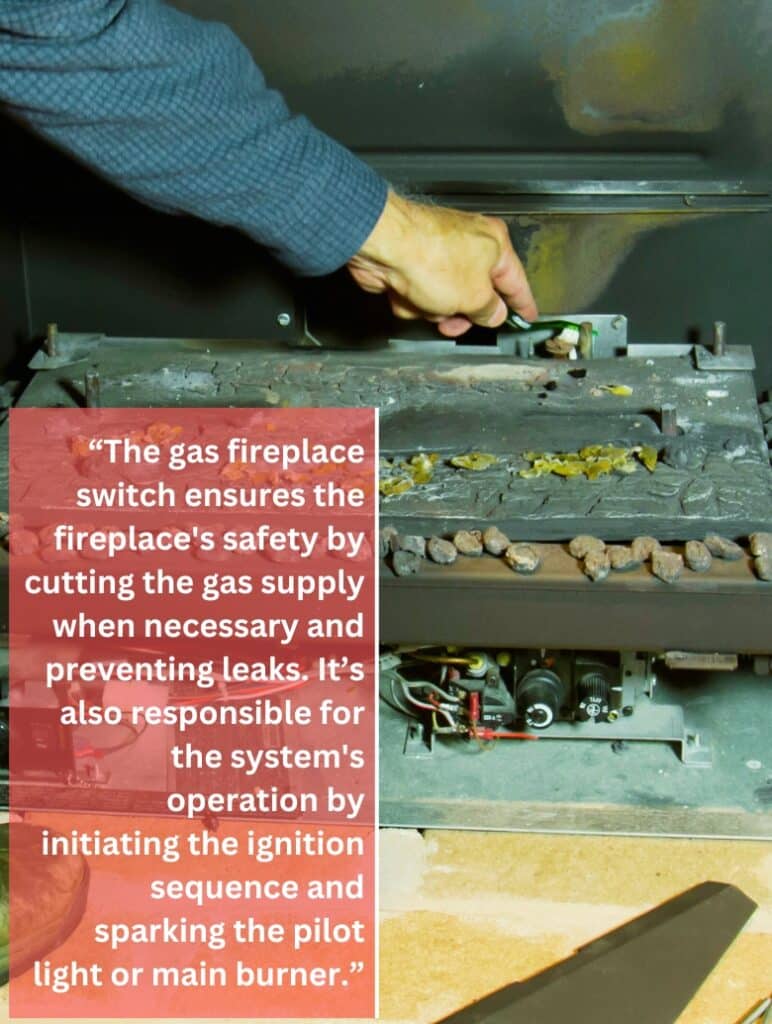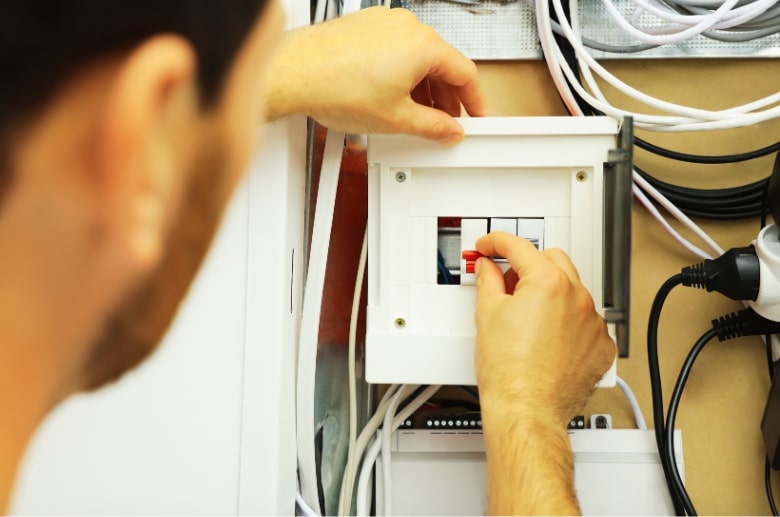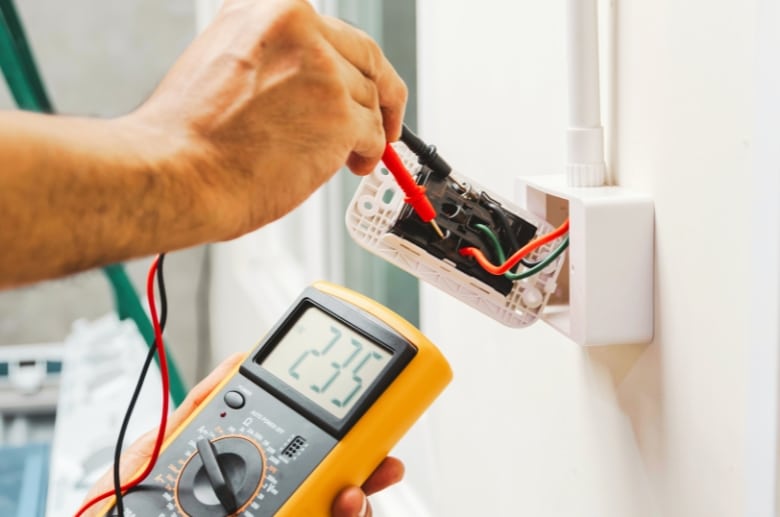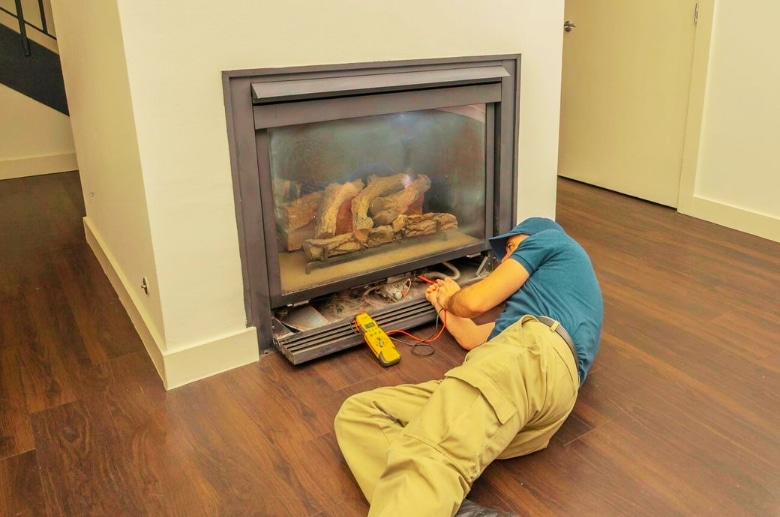While sitting next to the gas fireplace, sipping hot cocoa, and enjoying the warmth and the comforting ambiance in the cold winter, we hardly remember a crucial component behind this cozy scene—the gas fireplace switch.

The gas fireplace switch ensures the fireplace’s safety by cutting the gas supply when necessary and preventing leaks. It’s also responsible for the system’s operation by initiating the ignition sequence and sparking the pilot light or main burner.
More often than not, you can find yourself facing a common issue where your gas fireplace switch won’t work. That’s precisely why we’ve crafted this guide.
——
Do You Need to Hire Chimney & Fireplace Expert?
Get free quotes from qualified experts near you. No commitment required!
——
How Does a Gas Fireplace Switch Work?
Once you engage the gas fireplace switch, whether a standard wall switch or a more advanced smart switch, it sends an electrical signal through the wiring and terminals connecting the switch to the gas fireplace system. Most gas fireplaces use the millivolt switch system.
This system utilizes either a thermocouple or a thermopile to produce a minute electrical voltage. A thermocouple is a temperature sensor consisting of two metal wires joined at one end. It produces a voltage in response to temperature changes, allowing it to measure temperature accurately.
Conversely, a thermopile is a device made up of multiple thermocouples connected in series or parallel. It generates a larger electrical voltage or current output compared to a single thermocouple.
As mentioned, these two produce a minute electrical voltage ranging from 650 to 750 millivolts. This meager electrical output can activate a magnet within the gas valve, enabling gas flow to the pilot light and the main burner.
In case of malfunction, gas fireplace repair becomes necessary to ensure that these components are functioning correctly, preventing issues such as inadequate heating or safety hazards.
5 Common Reasons Why Your Gas Fireplace Switch Won’t Work
It can be incredibly frustrating and disheartening if you’ve attempted to ignite your gas fireplace only to find it unresponsive. This lack of response might be attributed to one of the following reasons:
1. Electrical Issues
Electrical problems are a common source of trouble for gas fireplace switches, hampering their operation. These issues can be traced back to several root causes.

Blown Fuse or Tripped Circuit Breaker
A blown fuse or a tripped circuit breaker often stems from power surges, short circuits, or an overload of electrical devices. When these protective mechanisms intervene, they can disrupt the power supply to your gas fireplace switch, rendering it inactive.
Damaged or Loose Wires
Wires can deteriorate over time due to wear and heat exposure. Loose connections can also occur during installation or over time. These issues can impede the flow of electricity, affecting the switch’s performance.
Incorrect Wiring Diagram Followed During Setup
Using an incorrect wiring diagram during the initial installation of your gas fireplace system can lead to misconnections and problems down the line. Gas fireplace systems can be diverse in design and requirements, and a mismatched wiring diagram can hinder proper functioning.
Power Outage Affecting the Circuitry
Whether brief or prolonged, power outages can disrupt the functionality of gas fireplace switches, particularly if your system relies on external power sources. Electronic components may be affected, leading to temporary or ongoing issues.
Now that you understand the various causes behind electrical issues, here are tips to help you troubleshoot them:
- Check your home’s electrical panel for blown fuses or tripped circuit breakers and address them accordingly.
- Inspect the wiring connecting the switch to the gas fireplace system for damage or loose connections and make the necessary repairs.
- Verify that the wiring follows the correct diagram provided by the manufacturer to ensure compatibility.
- Consider backup power solutions like uninterruptible power supplies (UPS) to maintain electrical continuity during power outages.
2. Faulty Thermocouple or Thermopile
To understand the significance of the thermocouple and thermopile in a gas fireplace, let’s first explore their roles and functions within the system.
Thermocouple
A thermocouple is a small, heat-sensitive device located near the pilot light of your gas fireplace. Its primary function is to act as a safety feature. When the pilot light is lit, the thermocouple generates a small electrical voltage based on the heat it detects.
This voltage holds open a magnetic valve in the gas line, allowing gas to flow to the pilot light.
But if the pilot light goes out or becomes too weak, the thermocouple cools down, producing less voltage. This prompts the magnetic valve to close, shutting off the gas supply and preventing dangerous gas leaks.
Thermopile
Similar to the thermocouple, a thermopile also generates electrical voltage. However, it’s often used to power other electrical components in the gas fireplace, such as a remote control system or a wall switch.
It consists of multiple thermocouples connected in series, producing a higher voltage than a single thermocouple. This voltage can be used to operate electronic ignition systems and other features.
Now, let’s explore some common problems that may arise with these crucial components:
Corrosion
Over time, the thermocouple or thermopile may develop corrosion due to exposure to moisture or other environmental factors. This hinders their ability to generate voltage effectively—hence, your gas fireplace switch won’t work.
Malfunctioning Pilot Light
If the pilot light is weak or fails to stay lit, it can affect the performance of the thermocouple. The thermocouple may not generate sufficient voltage to keep the gas valve open without a consistently strong pilot light.
So, how do you troubleshoot, check, and replace faulty thermocouples or thermopiles? The following tips should help you out:
Visual Inspection
Examine the thermocouple and thermopile for visible signs of corrosion or damage. If corrosion is present, it may be possible to clean it using fine sandpaper or steel wool.
Pilot Light Inspection
Ensure that the pilot light is burning steadily and is the correct size. If it is weak or flickering, clean the pilot orifice. Consider having a professional technician assess and adjust the pilot light if the issue persists.
Voltage Testing
Using a multimeter, measure the voltage output of the thermocouple or thermopile. A thermocouple should typically produce around 25-30 millivolts when heated, while a thermopile voltage output is within the manufacturer’s specified range. If the output is significantly lower than expected, replacement may be necessary.
Replacement
If corrosion is extensive or the voltage output is consistently low, replacing the thermocouple or thermopile is advisable even after cleaning and adjustment. Ensure you use the correct replacement parts that match your gas fireplace model.
——
Do You Need to Hire Chimney & Fireplace Expert?
Get free quotes from qualified experts near you. No commitment required!
——
3. Dirty or Faulty Ignition System
The ignition system plays a crucial role in ensuring the safe and efficient ignition of the pilot light and, consequently, the main burner. However, it’s susceptible to common issues from accumulating dirt, debris, and wear and tear on its components over time.
When dirt, soot, or other debris accumulate on the ignition components, they obstruct their ability to generate a spark or the necessary heat for pilot ignition. This significantly reduces the effectiveness of the ignition system, potentially leading to unreliable ignition or even complete failure.
How to Clean and Maintain the Ignition System
So, how do you clean and maintain the ignition system to prevent problems? Here are tips to ensure your ignition system stays at its best:
- Inspect the ignition components for dirt, soot, or debris, and carefully clean them using a soft brush or compressed air to remove any buildup.
- Suppose you notice damaged or malfunctioning ignition components, such as a spark igniter not sparking or a hot surface igniter not heating up. In that case, you will need to replace them with compatible parts.
- Maintain a clean fireplace area to prevent debris from entering and interfering with the ignition system.
- Regularly seek the assistance of a professional team specializing in gas fireplace servicing to assist with the cleaning.
4. Wall Switch Issues

Wall switch problems are another roadblock to enjoying the warmth of your gas fireplace. Here are some common reasons behind wall switch issues:
Corrosion on the Switch’s Contacts
Over time, corrosion can develop on the switch’s electrical contacts. This disrupts the flow of electricity when the switch is toggled, preventing it from effectively sending the signal to ignite the fireplace.
Malfunction of the Toggle Switch
Like other parts, toggle switches wear out or become damaged. This limits the toggle switch from making proper contact when you attempt to turn on the fireplace, leading to switch-related issues.
Connection Issues in Fireplace Wall Switches
Loose or damaged wires, faulty terminations, or problems within the switch’s electrical connections can all hinder its operation. You’ll have difficulty with switching on your gas fireplace when either occurs within the wall switch system.
Alternative Switches Like Smart Switches or Remote Control Panels Not Syncing
Sync problems normally occur due to issues with the wireless communication between the switch and the fireplace system. However, low battery power in remote control units and software glitches in smart switches can also cause problems with syncing.
5. Gas Pressure Issues
The gas fireplace switch relies on gas pressure to control gas flow to the pilot light and main burner. Insufficient gas pressure can hinder the switch’s ability to ignite the fireplace, while excessive pressure may pose safety risks. The switch typically operates within a specific pressure range prescribed by the manufacturer.
So, how do you troubleshoot gas pressure issues? Here are a few tips to see you through:
- Check the gas supply valve and ensure it is fully open.
- Inspect the pressure regulator for consistent gas pressure.
- Measure the gas pressure using a manometer and confirm it’s within the manufacturer’s recommended pressure range.
Now that you’ve successfully solved gas pressure issues in your system, how do you adjust the gas pressure?
Adjusting gas pressure should only be performed by a licensed professional or technician with experience working on gas systems. Attempting to DIY may cause safety issues. Here’s an overview of the steps to expect from a professional:
- Step 1. Before making any adjustments, the technician will ensure the gas supply to the fireplace is turned off.
- Step 2. They will then locate the pressure adjustment screw.
- Step 3. Afterward, they consult the manufacturer’s documentation for precise instructions on accessing and adjusting this screw. This is because various models have different procedures for gas pressure adjustment.
Prevention and Maintenance Tips

To ensure your gas fireplace continues to operate efficiently, consider the following essential maintenance measures:
Regular Inspection
Conduct periodic visual inspections of your gas fireplace switch to identify any signs of wear or damage. Early detection can prevent larger issues down the line.
——
Do You Need to Hire Chimney & Fireplace Expert?
Get free quotes from qualified experts near you. No commitment required!
——
Keep it Clean
Keep the area around the switch clean and free from debris. Dust and dirt can infiltrate the switch, leading to malfunctions.
Proper Ventilation
Ensure proper ventilation for your gas fireplace to prevent the accumulation of carbon buildup, which can affect the switch’s performance.
Check Your Gas Lines and Connections
Inspect gas lines and connections for leaks or loose fittings. Address these issues promptly to maintain safety and efficiency.
Book Your Annual Professional Inspection
Schedule an annual inspection by a qualified contractor. They can comprehensively evaluate your gas fireplace, including the switch, to identify and address potential problems.
Benefits of Proactive Maintenance of Gas Fireplaces
Here are some of the advantages of engaging in proactive maintenance for gas fireplaces:
1. Regular maintenance ensures that safety features function correctly, reducing the risk of gas leaks or other hazards.
2. A well-maintained gas fireplace operates more efficiently, providing better heat output while conserving energy.
3. Routine maintenance significantly extends the life of your gas fireplace switch and other components, saving you the cost of premature replacements.
4. Proactive maintenance helps identify and address issues early, preventing more extensive and costly repairs.
When to Seek Professional Help
Seeking professional assistance for gas fireplace issues can significantly enhance safety and efficiency. Here are other situations when professional help is essential:
Persistent Switch Issues
If your gas fireplace’s ignition switch consistently malfunctions seek professional help to prevent potential hazards.
Complex or Uncertain Situations
In cases where you’re unsure about troubleshooting or repair, consulting a professional ensures proper diagnosis and resolution.
Gas Leaks or Odors
To avoid safety risks, immediate professional assistance is mandatory if you detect gas leaks or unusual odors near your gas fireplace.
Annual Inspections
Regular inspections by professional contractors ensure your gas fireplace operates safely and efficiently year-round.
Conclusion
The functionality of a gas fireplace switch is crucial for both the comfort and ambiance it provides in our homes. When issues arise, causing the gas fireplace switch to malfunction, it becomes essential to promptly address these problems.
We highly recommend timely troubleshooting and regular maintenance to ensure your switch operates optimally. Also, seek professional advice for more complex jobs to ensure your safety and that of your household.






